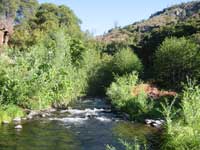About the Project
Project History
The Battle Creek Salmon and Steelhead Restoration Project (Restoration Project) has a long history that includes research by various organizations and collaboration among many resource agencies and public interest groups. View a timeline of important Restoration Project milestones (PDF - 62 KB).
In early 1999, a cooperative effort among the U.S. Department of Interior, Bureau of Reclamation, the U.S. Fish and Wildlife Service, National Marine Fisheries Service, the California Department of Fish and Game, and the Pacific Gas and Electric Company (PG&E) led to the signing of an Agreement in Principle to pursue a restoration project for Battle Creek. In mid-1999, the parties signed a detailed, formal Memorandum of Understanding (MOU) (PDF - 736 KB) in conformance with the Agreement in Principle.
Project Purpose, Location, Description, and Importance
The purpose of the Restoration Project is to restore approximately 42 miles of habitat on Battle Creek and an additional 6 miles of habitat on tributaries to Battle Creek for threatened and endangered salmon and steelhead, while minimizing the loss of clean and renewable energy produced at PG&E's Battle Creek Hydroelectric Project (Hydroelectric Project) - Federal Energy Regulatory Commission (FERC) Project No. 1121.
The Restoration Project is located (location map [PDF - 1.4 MB]) in Shasta and Tehama Counties near the town of Manton, California. The Restoration Project area (PDF - 2.5 MB) consists of the portion of the Hydroelectric Project below the natural fish barriers on North Fork Battle Creek and South Fork Battle Creek, and above the confluence of the Coleman Powerhouse tailrace channel and the mainstem of Battle Creek. The upper project limit on North Fork Battle Creek is the absolute natural fish barrier above North Battle Creek Feeder Diversion Dam, 14 miles upstream of the confluence. The upper project limit on South Fork Battle Creek is the natural fish barrier above South Diversion Dam.

The Restoration Project is being accomplished by modifying a portion of the Hydroelectric Project facilities in three phases (Phases 1A, 1B and 2) (PDF - 726 KB), including:
- Removing diversions dams and constructing fish screens and ladders on other diversion dams to provide safe passage for fish.
- Preventing the mixing of North Fork Battle Creek and South Fork Battle Creek waters, through the construction of powerhouse bypass and tailrace connectors.
- Protecting a State trout hatchery from diseases carried by anadromous fish, through the construction of a fish barrier weir.
- Increasing instream flows, and dedicating water rights for instream purposes at dam removal sites.
- Implementing adaptive management to ensure fisheries objectives are met.
Habitat restoration would enable safe passage for naturally produced salmonids and would facilitate their population growth and recovery in the Sacramento River and its tributaries. These salmonids include Central Valley spring-run Chinook salmon, state- and federally listed as threatened; Sacramento River winter-run Chinook salmon, state- and federally listed as endangered; and Central Valley steelhead, federally listed as threatened.
Within the past century, anadromous salmonid fish species in the Sacramento River system have declined because of a number of factors, including the loss and degradation of spawning habitat as a result of changes in hydrologic regimes caused by water management for flood control, irrigation, and hydropower production. In order to preserve and enhance current salmonid populations within the Sacramento River system, habitat restoration efforts are needed. An opportunity to restore uniquely valuable habitat exists in Battle Creek, a tributary to the Sacramento River.
The restoration of a drought-resistant, spring-fed system like Battle Creek is especially important to species such as winter-run and spring-run Chinook salmon and steelhead, which are dependent on cool water stream habitats. Winter-run Chinook salmon are dependent upon habitats like Battle Creek that have stream reaches that are kept cool year-round by natural springs. Historically, winter-run Chinook salmon populations occurred in Battle Creek, but at present, the only significant population of winter-run Chinook salmon occurs in the mainstem of the Sacramento River below Shasta Dam (Yoshiyama et al. 1998). This section is kept cool by releases from Shasta Lake, the reservoir above Shasta Dam. However, periods of extended drought could exhaust the reservoir's coldwater reserve, leaving the fish susceptible to reproductive failure. Because it is inevitable that serious drought conditions will affect Shasta Lake, it is necessary to have drought-resistant refugia available in the upper Sacramento River system for populations like winter-run and spring-run Chinook salmon that are sensitive to drought conditions.
References:
Yoshiyama, R.M., F. Fisher, and P. Moyle. 1998. Historic abundance and decline of Chinook salmon in the Central Valley region of California. North American Journal of Fisheries Management 18:487-520.
Note: Documents in Portable Document Format (PDF) require Adobe Acrobat Reader 5.0 or higher to view, download Adobe Acrobat ReaderLast Updated: 7/13/22

